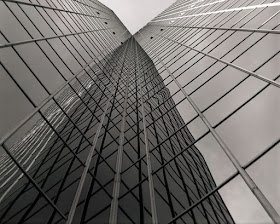The camera shared nearly all of its basic features with every other simple box camera from the preceding fifty years, but the design, construction, materials and functions represented the ultimate evolution of the box camera idea. The brilliant waist-level finder was one of the brightest put in a simple camera, the bakelite case was nearly indestructible, and the smooth, rounded form along with the gracefully fluted sides made the camera a pleasure to hold. The most superlative feature, though, was the extraordinary lens, a simple meniscus design. Somehow – in a way I certainly don't understand – the single lens which is located behind the camera's one-speed shutter is able to produce images of astounding sharpness.
 |
| El Paso |
 |
| Dead Man's Curve |
The commonest close-up lens, the No. 13, allowed the photographer to get to within about 3.5 feet of the subject - ideal for portraits and other close studies. It has also been suggested that adding the close-up lens provided some correction of aberrations of the simple meniscus design of the main lens.
 |
| Margaret |
The camera, while advanced in many ways, was not perfect. While it had a time release function activated by the slide opposite the shutter, there was no cable release to help avoid camera movement during a long exposure. There was also no tripod mounting receptacle. Probably the biggest weakness in the camera, however, was a rather stiff shutter which tended to jar the camera when released, causing a blurred image if extraordinary care was not exercised in bracing the camera against the body or some handy object. Of course, it is not terribly difficult to rig up some kind of jury-rig tripod mount. A few people with good DIY skills have added cable release and tripod sockets to their Hawkeye Flash cameras. If you are not the handy type, Randy Smith of Holgamods can add the cable release and tripod socket to your Hawkeye Flash, as well as providing a number of other functional and cosmetic enhancements to the camera.
 |
| Chase Bank Building, Phoenix |
 |
| Forrester Ave., Albuquerque |
It is not usually necessary to remove the screws on either side of the top viewing screen; they are hard to take out and will probably be hard to put back. Just take out the screws above and below the lens ring on the front. Then, carefully lift the silver panel and remove the glass lens protector, the plastic retainer mount, and the front viewfinder lens for cleaning. You can reach in to clean the underside of the top viewfinder lens with a cotton swab.
The camera's lens and the shutter are accessed from inside the camera back. Remove the two phillips-head screws, take out the film holding frame and remove the lens and spring washer for cleaning. It might be a good idea to swab a little lighter fluid on the shutter mechanism at the same time. Be sure to replace the lens and washer in the proper order and orientation, and take care to properly seat the film holding frame. That's about it. Your camera is good for another fifty years, and maybe a couple more owners.
Some Hawkeye Flash Links:
- Rejuvenating your Brownie Hawkeye
- A Hawkeye Flash user manual is available on line.
- My flipped lens photos from the Hawkeye Flash
- Great Hawkeye Flash work by Eric J. Henderson
- An amazing animation of BHF construction


These are very nice photos. The quality is as good as you can get and you have quite the eye for suitable subjects. I've thought this was an underrated little box, but it seems like it does have a fan base of users.
ReplyDeleteHope to see more of your photos made with this jewel of a camera.
This is a slightly cleaned-up version of material from my web site which I took off line some time ago. I was browsing through the Hawkeye Flash group at Flickr and found there was still a link there in the "Overview" section to the now gone site. I asked the group moderator to remove the link as clicking on a dead link can end up redirecting people to malicious content.
ReplyDeleteThe Hawkeye Flash really is capable of making fine images, and I definitely need to run some film through mine again. I am glad to see that people are developing some interest in many of the old film cameras again. I'm not sure how that is going to play out exactly, though. Web sites, blogs and Flickr group discussions seem to be attracting few users, and social media does not really seem to provide a nourishing environment.